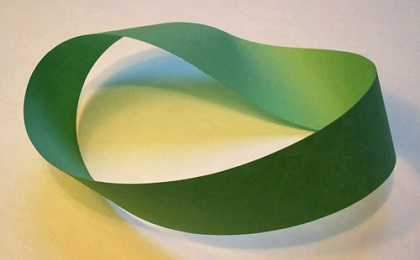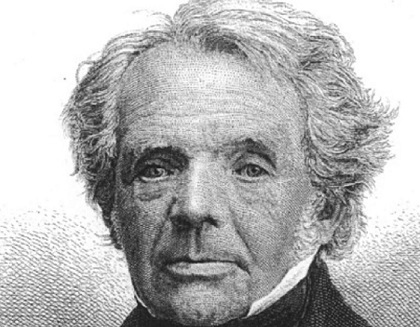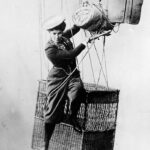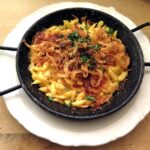 The Möbius strip or Möbius band is a surface with only one side and only one boundary component. The Möbius strip has the mathematical property of being non-orientable. It can be realized as a ruled surface. It was discovered independently by the German mathematicians August Ferdinand Möbius and Johann Benedict Listing in 1858.
The Möbius strip or Möbius band is a surface with only one side and only one boundary component. The Möbius strip has the mathematical property of being non-orientable. It can be realized as a ruled surface. It was discovered independently by the German mathematicians August Ferdinand Möbius and Johann Benedict Listing in 1858.
August Ferdinand Möbius (November 17, 1790 – September 26, 1868) was a German mathematician and theoretical astronomer.
He is best known for his discovery of the Möbius strip, a non-orientable two-dimensional surface with only one side when embedded in three-dimensional Euclidean space. It was independently discovered by Johann Benedict Listing around the same time. The Möbius configuration, formed by two mutually inscribed tetrahedra, is also named after him. Möbius was the first to introduce homogeneous coordinates into projective geometry.
 A model of the Möbius strip can be easily created by taking a paper strip and giving it a half-twist, and then joining the ends of the strip together to form a loop. In Euclidean space there are two types of Möbius strips depending on the direction of the half-twist: clockwise and counterclockwise. That is to say, it is a chiral object with “handedness” (right-handed or left-handed).
A model of the Möbius strip can be easily created by taking a paper strip and giving it a half-twist, and then joining the ends of the strip together to form a loop. In Euclidean space there are two types of Möbius strips depending on the direction of the half-twist: clockwise and counterclockwise. That is to say, it is a chiral object with “handedness” (right-handed or left-handed).
The Möbius band (equally known as the Möbius strip) is not a surface of only one geometry (i.e., of only one exact size and shape), such as the half-twisted paper strip depicted in the illustration to the right. Rather, mathematicians refer to the (closed) Möbius band as any surface that is homeomorphic to this strip. Its boundary is a simple closed curve, i.e., homeomorphic to a circle. This allows for a very wide variety of geometric versions of the Möbius band as surfaces each having a definite size and shape. For example, any closed rectangle with length L and width W can be glued to itself (by identifying one edge with the opposite edge after a reversal of orientation) to make a Möbius band. Some of these can be smoothly modeled in 3-dimensional space, and others cannot. Yet another example is the complete open Möbius band. Topologically, this is slightly different from the more usual — closed — Möbius band, in that any open Möbius band has no boundary.
 While the idea of Mobius strip architecture has been tackled before, perhaps no scheme has been so ambitious as Vincent Callebaut’s “Swallow’s Nest,” a proposed arts and literature center for the Taiwanese city of Taichung.
While the idea of Mobius strip architecture has been tackled before, perhaps no scheme has been so ambitious as Vincent Callebaut’s “Swallow’s Nest,” a proposed arts and literature center for the Taiwanese city of Taichung.
Composed of a series of isosceles triangles gradually rotated around an ellipse, the building creates a dramatic division between interior and exterior while allowing the integration of public space into the center of the building by means of “the Infinite Patio.” The twisting of the structure also allows for three large vaulted spaces for the display of art objects.
The Möbius strip concept is also widely used in jewelry design.
The Euler characteristic of the Möbius strip is zero.







